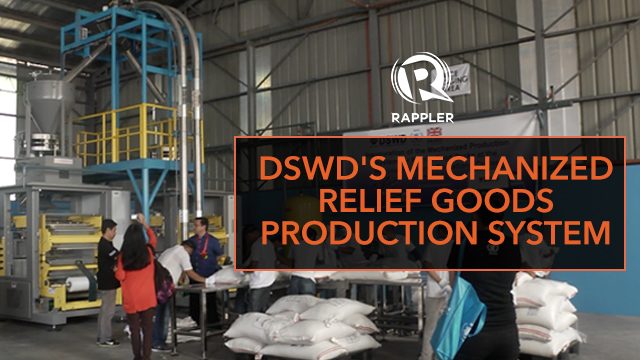SUMMARY
This is AI generated summarization, which may have errors. For context, always refer to the full article.

Learning from previous disasters, the Department of Social Welfare and Development (DSWD) launches a new mechanized production system that makes repacking of relief goods faster and more efficient during disasters.
Gwen de la Cruz reports.
When Typhoon Yolanda struck in 2013, it took days for relief goods to reach victims.
Two years later, the Department of Social Welfare and Development or DSWD, in partnership with the World Food Programme, has a new mechanized production system that has the capacity to produce 50,000 family food packs a day.
A big leap from the 10 to 15 thousand food packs per day that volunteers could put together.
These food packs, which include rice, canned goods and coffee, can feed 250,000 people in 2 to 3 days.
Machines do the tedious tasks of measuring, sorting, repacking, and storing.
This makes everything quicker, using less manpower, reducing to 30 personnel and volunteers needed during operations.
During emergencies, a truck can be filled with 2,400 family food packs in over an hour.DSWD Secretary Dinky Soliman says this new system will also lessen food spoilage.
DINKY SOLIMAN, SECRETARY, DEPARTMENT OF SOCIAL WELFARE AND DEVELOPMENT: In this system, we can monitor the expiration dates of relief goods. For example, you can see a card there indicating when the goods are processed and when the goods will expire.
To quickly distribute relief goods, the DSWD works with the Armed Forces of the Philippines and the World Food Programme.
DINKY SOLIMAN, SECRETARY, DEPARTMENT OF SOCIAL WELFARE AND DEVELOPMENT: We have this, again, suggested by the World Food Programme, pre-arranged contracts that we can utilize whenever we need them – these are private 10-wheeler covered trucks. So that when disaster strikes, we don’t need to look for trucks anymore.
The whole system, according to Soliman, is one-of-its-kind, specifically designed for the agency’s needs.
By the end of the year, the DSWD will set up another system in Cebu. Two more systems will be set up in General Santos and Clark by 2016.
The Philippines is considered the third most disaster prone country in the world according to the 2012 World Risk Index.
With the new mechanized production system in place in different parts of the country, are we one step closer to a more efficient disaster management plan?
Gwen de la Cruz, Rappler, Manila
Add a comment
How does this make you feel?
There are no comments yet. Add your comment to start the conversation.